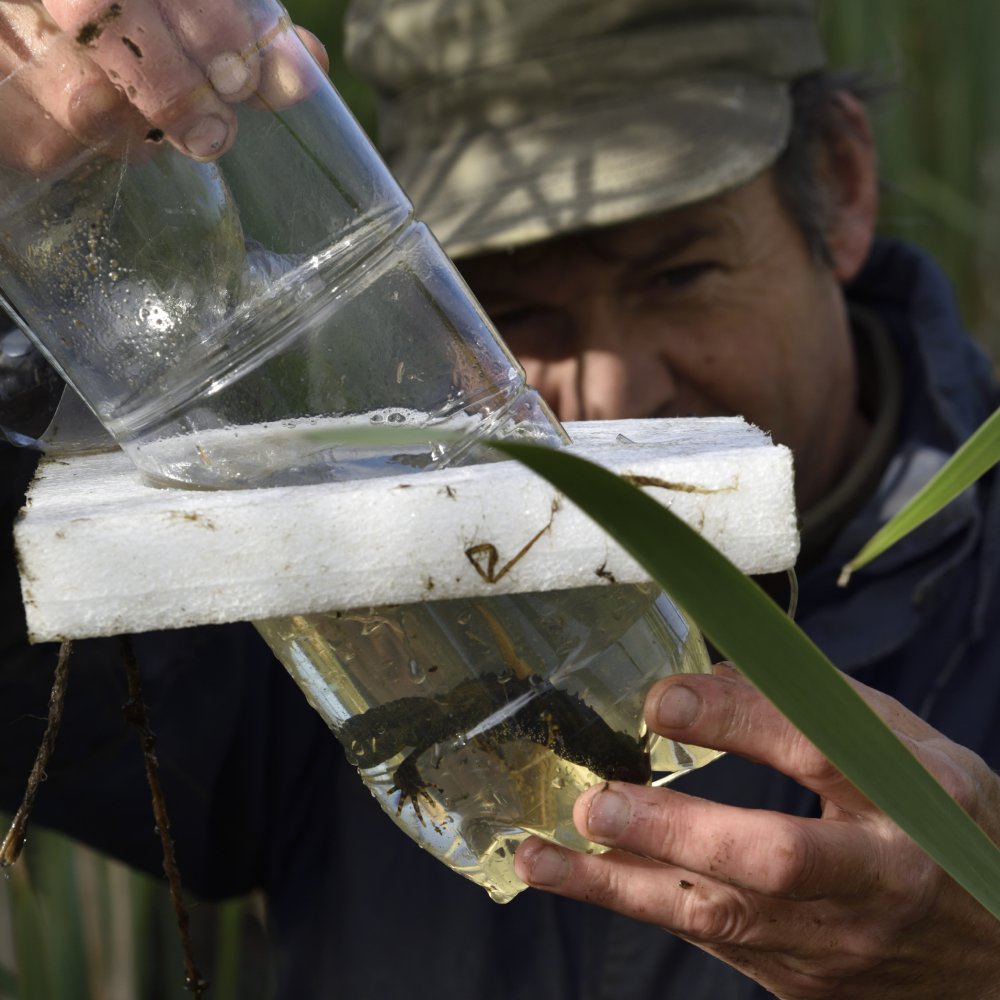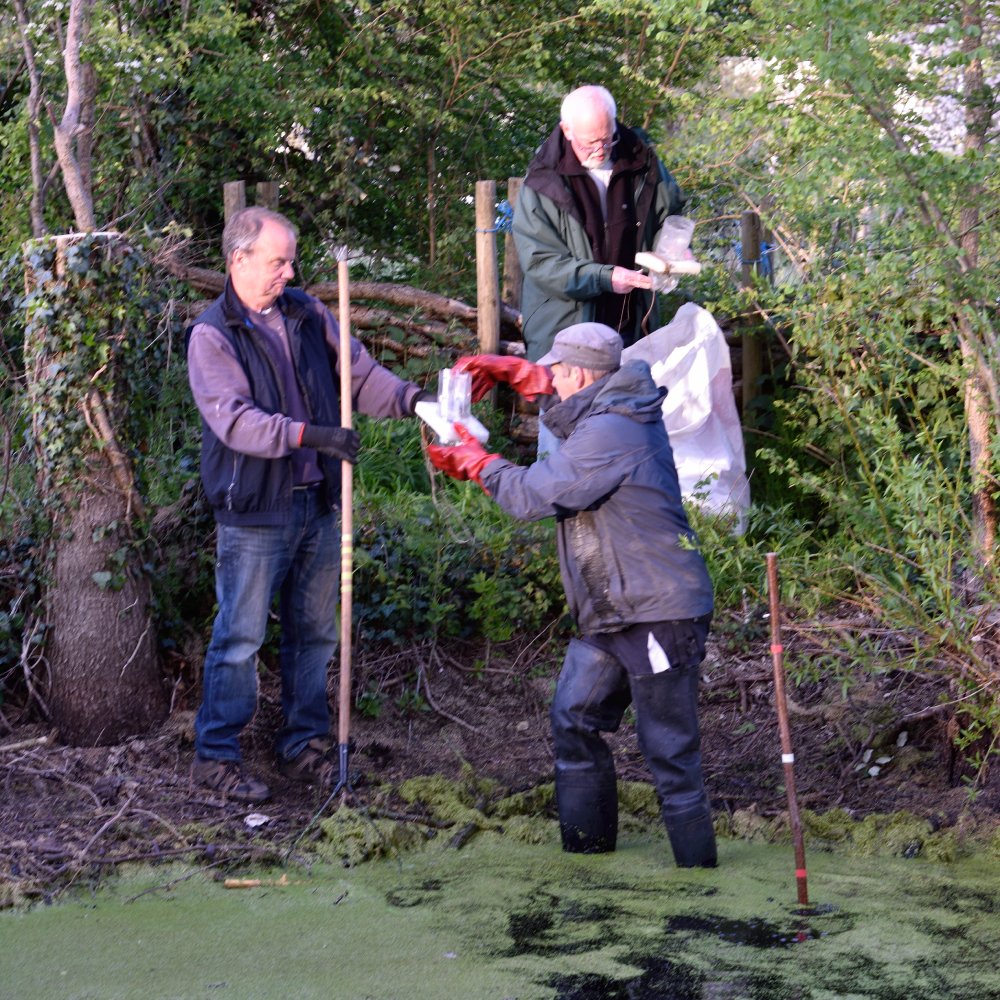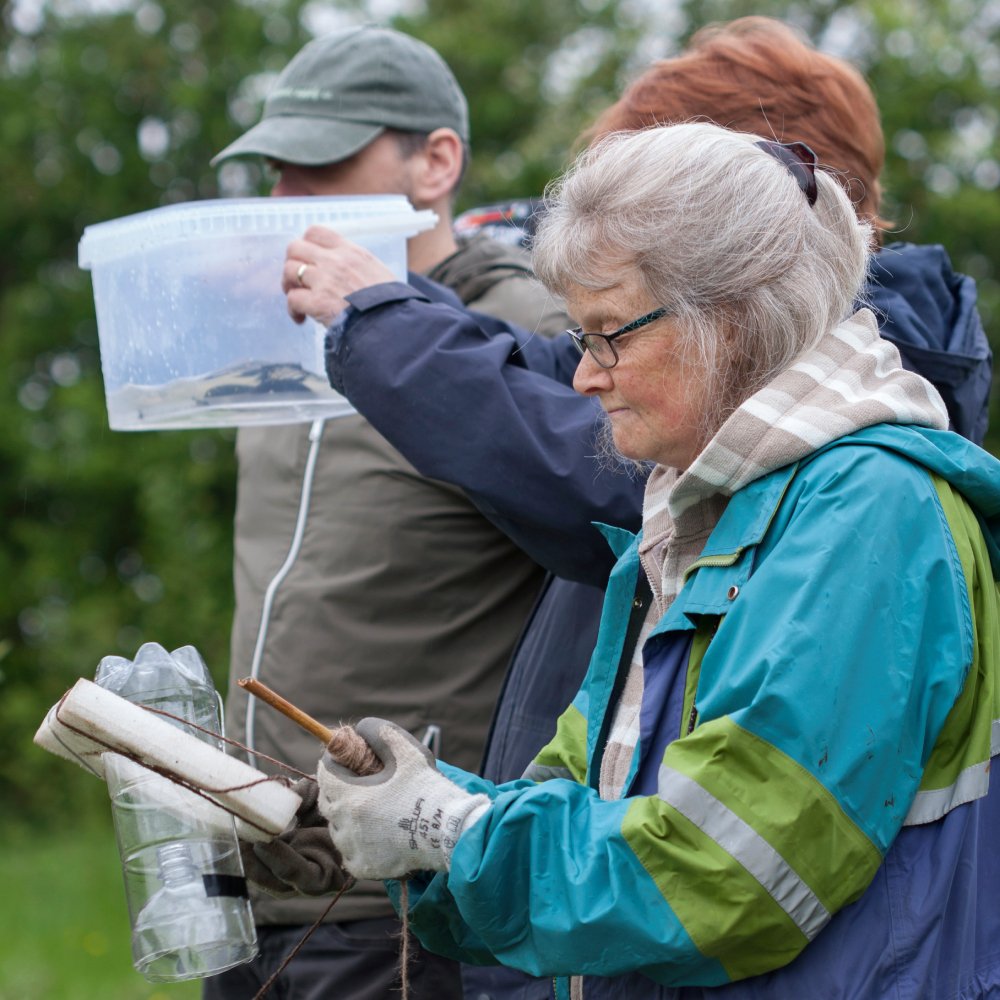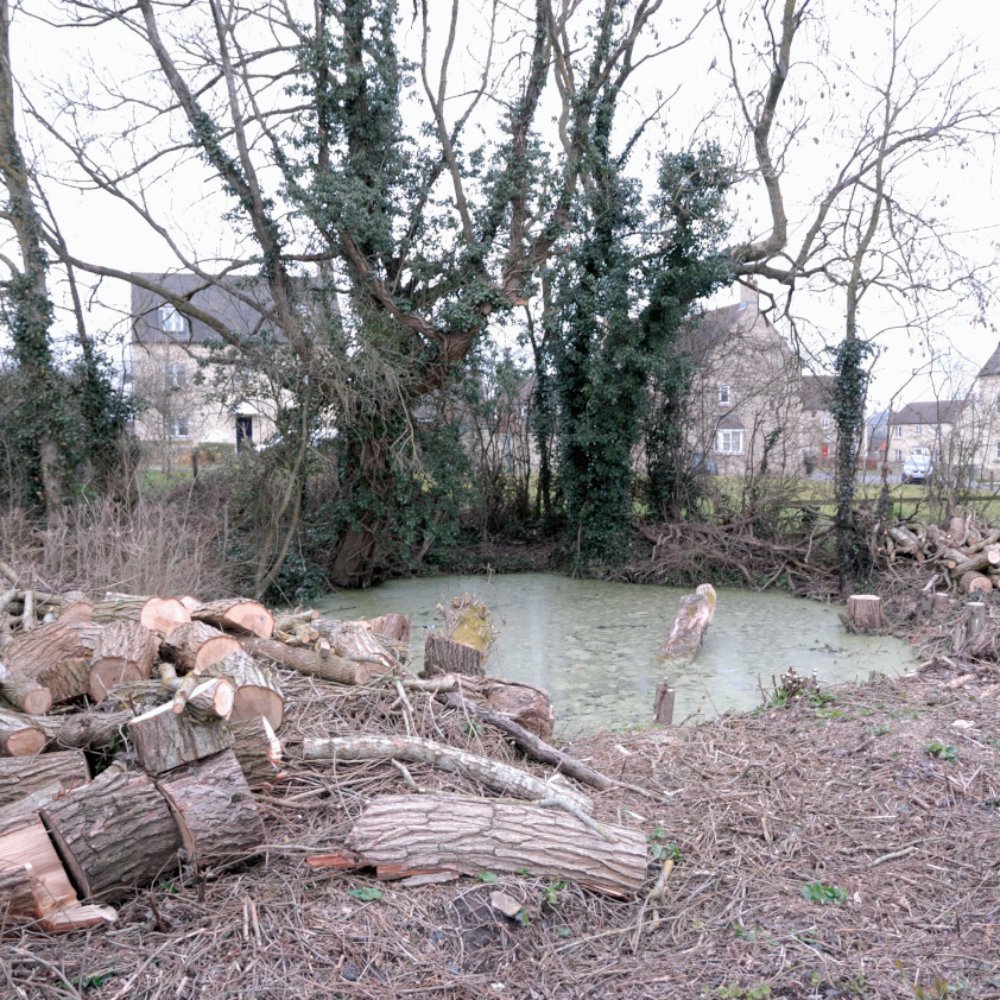Wild about Kingswood
Stroud Valleys Project, in partnership with Kingswood Parish Council and the local community, set up the exciting ‘Wild about Kingswood’ project to restore and enhance a mosaic of habitats. The wildlife habitats that the nature reserve consist of include ponds - which are home to Great crested newts (GCNs) - grasslands, woody areas, an orchard, hedgerows and ditches. As a collective of different types of habitat they offer great spaces for newts, other amphibians and wildlife that might live or pass through the site at regular intervals.
These wildlife areas provide lots of opportunity for the local community and general public to get involved in looking after and improving this wild haven, which has shown great potential for both wildlife and people.
Spring 2025 update:
Royal results at Kingswood by Richard Lewis
Over the last few autumn and spring months, the Wild About Kingswood volunteer group have been planting hedgerows, doing some Hazel coppice creation and doing the fine art of hedge laying.
At the end of December 2024, the group undertook a partnership project with Kingswood Parish Council and ourselves to plant over 450 mixed hedgerow species around the parish-based community allotments and the wildlife area’s linear orchard and boundary. I must admit that at the start, I was quite daunted at the prospect of having the time, weather and people to achieve the task. I really must thank all the group for their stamina and determination to really ‘make hay while the sun shines’.
We were very lucky through the first months of the year not to be rained off from planting the hedgerow; this really gave us all the kickstart we needed to achieve the large number of saplings to be planted before the end of March.
This leads me nicely onto another bit of winter/autumn work of hedge laying, at which the group have become quite skilled. The hedgerow that we as a group have embarked upon is one of the first projects that SVP undertook, at the newt ponds some seven to eight years ago... how time does fly.
The picture shows five sessions of hedge laying work that the team achieved from the middle of January to the first week in March (the end of the season); at this point, the sap is rising in the plant to give it leaf and flower for the spring and summer ahead.
If managed appropriately, the newly planted hedgerow will, over its first seven to eight years of life, be a source of shelter, food and habitat.
Later on – seven to nine years down the line – it will make a stock-proof, thick and dense hedge for all wildlife to enjoy.
Autumn 2024 update:
New wheels and the ‘living art’ of hedge laying at Kingswood by Richard Lewis
Work at Kingswood near Wotton-under-Edge this year has been made a little easier for the volunteers onsite as the group now has a new petrol-driven mower. The mower was kindly bought by Kingswood Parish Council to aid the work of maintaining our footpaths. Next job is mowing paths through managed wildlife-rich grassland areas in each field compartment, which gives visitors the opportunity to get closer to wildlife without intruding.
The growth of all the hedgerows has been staggering during recent months: a good two to three feet growth on some of the hedgerow species. This has given the group the opportunity to cut, trim and shape the hedgerows with arising waste put aside for either habitat piles or a group bonfire.
As we’ve been moving through this damp type of summer into autumn, we’ve been able to catch a few wildlife photos either as we’ve been working or having a tea/coffee break. You can see a Knot Grass Moth caterpillar, found on hedgerow, and the other a beautiful Elephant Hawk-moth, found in one of the grassland swards.
It’s that time of year when we’re starting to think about further hedgelaying and the group and I have earmarked two sections in need of laying. We aim to start one in mid-November by removing the old fence and stakes in the hope of soon having stakes and bindings ready to start laying.
What is great about this hedgerow is that it’s one of the first habitat creation projects that we started in autumn 2016 when we started work here – it’s now over 12 feet high in places and in need of laying!
As we’ve planted the hedgerow and maintained the sideways-growing shape over the years, the hedgerow ‘should’ be easier to lay – I say ‘should’ but having learned from nearly two decades of hedgelaying experience, every hedgerow is different and naturally shaped.
It will however give us the opportunity to create another piece of living art.
Spring 2024: Making memories at Kingswood by Richard Lewis
SVP’s work at Kingswood newt ponds has continued over the last few winter months with the group completing another hedgerow project onsite.
The group have become quite confident with their experience at hedge laying and I have been really impressed and encouraged with their attitude towards our most recent hedgerow project. This last piece of work has been probably the hardest bit of hedge laying that we as a group have taken on, due to the fact that the hedge line was mainly made up of aged Elm, the majority of which were deadwood standing. The now newly laid hedge has also been planted where needed with over 100 hedgerow plants that have included Blackthorn, Hazel, Hawthorn and Guelder Rose. The group has also planted a number of native trees, Silver Birch and Rowan (Mountain Ash). The new trees and hedgerow plants will further increase biodiversity on an already thriving wildlife area.
The group at Kingswood also recently installed a new Oak bench in remembrance of John Robbins, one of the first group members from Kingswood who passed away just before Christmas. John, along with his grandson Charlie, helped out with the annual Great Crested Newt surveys for a number of years as well as being involved in the habitat management onsite. The new bench is sited next to the main breeding pond looking out across the grassland and laid hedgerows that John helped manage; a nice place to sit and take in nature and the wildlife space.
I know that John would have approved.
Autumn 2023: Headline newts by Richard Lewis
Our work at Kingswood on the newt ponds and green spaces has continued focusing on grass cutting and the control of scrub encroachment in and around the main pond area, orchards, and community spaces. This work provides different sward heights of grassland that provide foraging habitat for the Great Crested Newt (GCN) population and other wildlife.
As part of our work, we do an annual GCN survey of three ponds in and around the wildlife area using floating traps to count and then release newts.
In each pond, we set 10 floating traps early evening and then early morning. These when set correctly provide an air pocket in the top that gives amphibians suffiicient air to breathe until release the next morning.
Very rewarding to all the volunteers involved is the good number of GCNs, Smooth and Palmate newts found when surveying each year.
This year again, results during the main GCN breeding month of May have been excellent with both male and female GCNs found in two of the three ponds:. the picture shows a GCN’s beautiful underbelly
Once again encouraged by these results, we will continue to manage the areas for wildlife and the local community to enjoy.
Spring 2023: Radical change at Kingswood by Richard Lewis
The work at the Kingswood Newt Ponds has focused over the autumn and winter on the laying of two large hedgerow sections. Due to lack of management over the past 10 to 15 years, both hedgerows have become lines of trees, made up mainly of Hawthorn or dead/dying Elm.
As you can see by the before and after photos, hedge-laying work has been quite radical, with most of the Elm trees being coppiced and cleared and the Hawthorn laid to form a base, allowing space for growth and planting up with saplings.
In managing the green spaces for the Great Crested Newt (GCN) and other wildlife, we’ve been trying to strike a balance where appropriate so that there’s enough foraging grassland habitat and scrub area.
If this encroaching scrub is not controlled, vital foraging habitat will be lost, which could have a knock-on effect for the GCN population.
This work has not only provided a good learning curve for the volunteers, it has also given them further experience and enjoyment in the art of laying a mature hedgerow (a line of trees). Just as importantly, this work has also provided further hedgerow habitat that wildlife can use for cover, foraging and movement across the site.
As we now move into the spring then summer, work at the newt ponds will again be focused on the control of scrub encroachment and grass cutting, to the benefit of the local GCN population, other wildlife and the residents of Kingswood.
Autumn 2022: Autumn and winter’s habitat management work at Kingswood Newt Ponds has focused on the control of encroaching scrub in particular areas and laying two sections of hedgerow on the site.
The volunteers have spent several sessions cutting back bramble, blackthorn and hawthorn saplings that have grown up around the main breeding pond area as well as in the main orchard and community spaces. This habitat work has been and will continue to be a priority where we have scrub encroaching onto grassland areas.
In managing the green spaces for the Great Crested Newt (GCN) and other wildlife, we’ve been trying to strike a balance where appropriate so there’s enough foraging grassland habitat and scrub area. If this encroaching scrub is not controlled and pushed back, vital foraging habitat will be lost which could have a knock-on effect for the GCN population.
The flip side of this habitat loss has been the creation of two further laid sections of hedgerow; one that was originally an old hedgerow in need of laying and restoring and the other a younger section of hedgerow that needed laying before it became a line of small trees. This work has not only provided great experience and enjoyment for the group, but has also provided further hedgerow habitat that wildlife can use for cover, foraging and movement across the site.
Here you can see a video of efts (aquatic young):- Kingswood efts
Some history of the project
The early days of the project
We arranged a number of public events, including three newt surveys over that first Spring season, which provided the project with a clearer picture of the size of the population of Great Crested Newts living in or around these wildlife areas. We were all very excited about working in this new area of the district and looked forward to welcoming new and existing Friends who wanted to take part in the surveying.
As we moved into the first winter, work started with managing the woodland area at the entrance to Tyndale View, cutting back the hedgerows and the scrub on the newt barriers.
The second summer
taken by Daryl Carpenter
A number of public events were held at the Wild About Kingswood site over the summer of 2017, some highlights being the annual Great Crested Newt survey, a bat walk, scything course (this work helps towards the continued management of the site for the GCN population and other wildlife) and pond survey.
Lots of work was done by volunteers cutting grassland areas across this wildlife site, and the volunteers also became a great team of pond bio-blitzers. In July, our volunteers Denise Gibbons and Barbara Wood, took part with others in a pond dipping ‘bio-blitz’ in the main pond. The reason for this exercise was to find out what life we have lurking in the pond. Highlights from the 15 different species found during the survey were 45 newt larvae (22 Great Crested, 23 Smooth), 13 Dragonfly nymphs, 10 Mayfly larvae and two very small Screech beetles, to name but a few. Over those summer months, to avoid interfering with the local wildlife residents (newts, toads, frogs and others), we spent time sensitively managing the grassland areas to create a varied grassland sward across the wildlife site. This process took a few weeks but we quickly reaped the rewards of having created a diverse grassland areas for the wildlife and public to enjoy.
Work then began on restoring the old dew pond onsite, the planting of two wildlife-friendly hedgerows, further access improvements and bulb planting, as well as the first stages of erecting a community shed and a seating area for people to enjoy.
More progress
Our volunteers built the project’s community shed and continued the hedgerow management work around the dew pond, with the old hedgerow being laid and gapped up with saplings and bindings tied in to give structure and support. This work also made the hedgerow great for wildlife by creating a small wildlife corridor linking two of the mature hedgerows onsite.
A number of bird boxes were also put up in the small woodland area, made by both the Tuesday Green Health Team and the Wednesday Kingswood group which can also be purchased from our eco shop at 8 Threadneedle St, Stroud.
The installation of two beautifully handmade benches was completed, one adjacent to the main breeding pond and the other next to the small woodland entrance to the Tyndale View housing estate. The right weather and the people power meant we could put the benches in over two consecutive weeks. A big THANK YOU to all the volunteers that were involved in the building and installing of the benches, as well as to Adrian Leaman and Dave Cockcroft who helped us make it all happen!
Further habitat management work involved the laying of over 150 feet of hedgerow, creating a boundary between the Great Crested Newt (GCN) refuge area and the public footpath that runs across the nature reserve. The volunteer team really enjoyed this hedge-laying project – a ‘work of art’ as quoted by a number of local residents and walkers as they stopped to chat.
To finish the hedgerow off and to give it more structure and support we added bindings (7–8 ft coppiced hazel) to the top of the hedgerow, weaving three together every 7 ft. Once complete, the hedgerow habitat not only provided good cover, refuge and food for local wildlife but also looked pleasing to the eye.
A big Thank You to all the volunteers and to the Parish Council for their continued support of the project. A special thank you too to Paul Green for the great photos he produces for us, capturing some of the work we do.





















